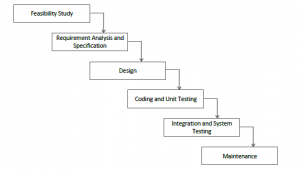What is the Waterfall Model?
Find the answers for What is Waterfall Model in SDLC? from here. The Waterfall Model, introduced by Winston Royce in 1970, is a software development process with five sequential phases: Requirements analysis and specification, design, implementation and unit testing, integration and system testing, and operation and maintenance. Each phase must be completed in order, and they do not overlap. This model gets its name from the cascade-like flow of the development process, where the completion of one phase triggers the beginning of the next.
Software Engineering Waterfall Model

- Requirements Analysis and Specification Phase – During the Requirements Analysis and Specification phase of software development, the goal is to comprehensively understand and properly document the customer’s requirements. To achieve this, both the customer and the software developer work together to document all the functions, performance, and interface requirements of the software. This phase is concerned with defining the “what” of the system to be developed and not the “how”. The end result is a Software Requirement Specification (SRS) document, which provides a detailed description of what the system will do in plain language.
- Design Phase – In the Design Phase of software development, the objective is to translate the requirements documented in the SRS into a suitable format that can be used for further coding in a programming language. This phase involves defining the software’s overall architecture, as well as both high-level and detailed design elements. The work done during this phase is documented in a Software Design Document (SDD).
- Implementation and Unit Testing – In the implementation and unit testing phase, the software design is transformed into an actual working system. The Software Design Document (SDD) created in the previous phase is used as a guide to code the system. The implementation is divided into small modules which are tested independently in the unit testing stage. Each module is tested to ensure it functions correctly and then integrated into the larger system. Once all modules are integrated, testing is conducted to ensure proper interaction and communication between modules. Any modifications required to ensure smooth operation are made during this stage.
- Integration and System Testing – This stage is known as Integration and System Testing, and it plays a vital role in ensuring the quality of the final product. Effective testing is crucial to achieving customer satisfaction, minimizing maintenance costs, and producing accurate results. While unit testing evaluates the performance of individual modules, this phase focuses on testing the interactions between modules as well as with the system as a whole.
- Operation and Maintenance Phase – The operation and maintenance phase involves the ongoing use and upkeep of the software after it has been delivered to the customer and is in operation. Maintenance is an essential task that is typically carried out by users to ensure that the software remains operational and meets the changing needs of the business. This phase can include tasks such as bug fixes, software updates, and system enhancements to improve the overall functionality and usability of the software.
Usage of Software Engineering Waterfall Model
The Waterfall model is best suited for certain circumstances, such as
- The Waterfall model is best suited for projects with constant and unchanging requirements.
- Situations, where there is little to no chaos, are good for implementing the Waterfall model.
- Consistency in technology and tools used is necessary for the Waterfall model.
- Short-term projects are also ideal for this model.
- Adequate resources must be available before implementing this model.
Advantages of the Classical Waterfall Model
- It is easy to implement, and the number of resources required for it is minimal.
- The release date and final cost of the complete product can be determined before development.
- A strict reporting system provides easy control and clarity for the customer.
- The requirements are explicitly defined and remain constant throughout the project’s development.
- The start and end points for each phase are fixed, which makes it easy to track progress.
Drawbacks of the SDLC Waterfall Model
- Higher risk factor, making it unsuitable for large and complex projects
- Difficult to go back to a previous phase once the project has moved on
- Inability to accommodate changes in requirements during development
- Testing is done at a later stage, making it harder to identify risks and challenges earlier in the process
Keep browsing our tutorials.freshersnow.com to get updated information about the Waterfall Model in SDLC.
